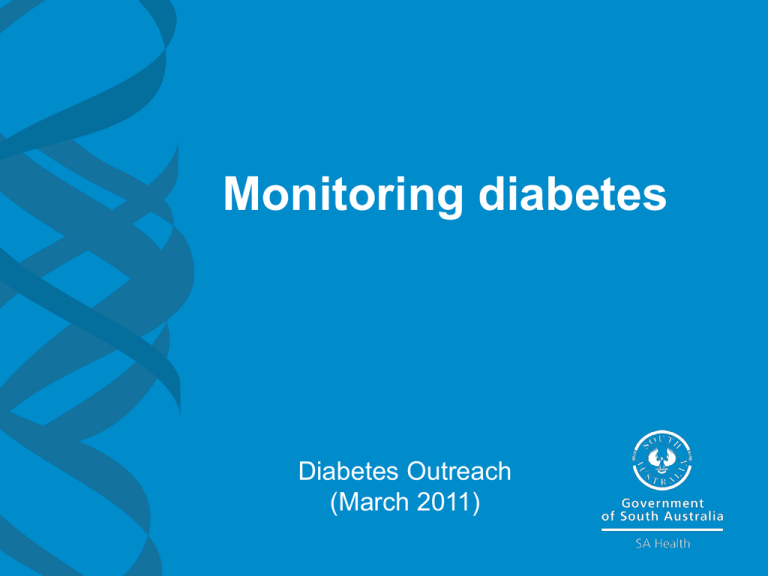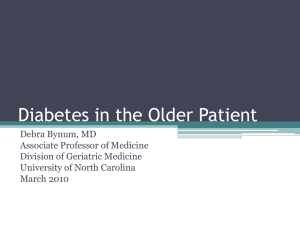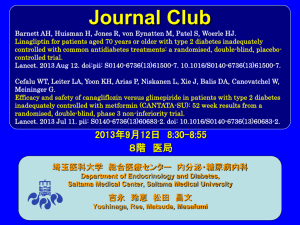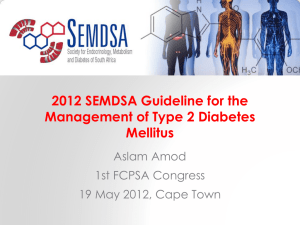When the Going gets Tough Blood Pressure
advertisement

Monitoring diabetes Diabetes Outreach (March 2011) Monitoring diabetes Learning outcomes > Define the purpose, methods and targets for blood glucose monitoring. > Understand the recommended frequency for testing in hospital and at home. > Be able to interpret results and identify appropriate action. > Understand when to test ketones. > Understand the need for quality assurance programs. > Be aware of the long term management of diabetes. 2 Monitoring diabetes control > Monitoring diabetes evaluates progress for the adjustment of therapy and lifestyle. > Monitoring diabetes includes: - diet - activity - clinical signs and symptoms - ketones 3 Monitoring diabetes control Controlling diabetes is important for: > health and a sense of well being for the individual > normal growth and development in children and adults > normal outcomes of pregnancy > lowering the incidence of illness and hospitalisation > prevention of long term complications. 4 Blood glucose monitoring > > > > > Can not be used to diagnose diabetes Can assist in therapeutic decision making Can detect hypoglycaemia Accurate technique is essential People can monitor their own BGLs at home. 5 What are the BG targets? Recommendations > The general HbA1c target in people with type 2 diabetes is ≤7%. Adjustment to diabetes treatment should be considered when HbA1c is above this level. > Targets for self-monitored blood glucose levels are 68mmol/L fasting and preprandial, and 6-10mmol/L 2hr postprandial. Practice point > An HbA1c target above 7% may be appropriate in people with type 2 diabetes who have a history of severe hypoglycaemia, a limited life expectancy, co-morbidities or who are elderly. Ref: NHMRC guidelines 2009 National evidence based guidelines for blood glucose 6 BG monitoring in health services/hospital > Health professionals should be competent in the use of blood glucose meters (eg biannual accreditation process). > Health services should adopt a quality assurance program to ensure accuracy of results. > All patients with diabetes should have BGL’s monitored regularly whilst in hospital. 7 Self blood glucose monitoring > All people with diabetes using insulin therapy or who are at risk of hypoglycaemia should be encouraged to test their own BGL’s. > For all other people appropriateness for SBGM should be assessed on an individual basis. > Individuals using blood glucose meters at home should have access to adequate self management education. 8 Blood glucose monitoring in hospital > Aim for BGL’s between 5 and 10mmol/L. > Check BGLs pre meal and 2100 hours unless patient is fasting and on IV insulin. > Frequency of monitoring in hospital should be assessed and documented regularly. > Notify MO if BGL >15mmol/L on 2 consecutive readings or >20mmol/L. 9 Blood glucose monitoring at home The targets and frequency of testing will depend on what type of diabetes the person has, the type of treatment they are on (diet, tablets or insulin) and the intensity of their regimen. What might you suggest for a person who is on basal insulin only? 10 Example: Home blood glucose testing DAY FASTING BEFORE LUNCH Monday x Tuesday x x Wednesday Thursday Friday x x Saturday x Sunday x BEFORE DINNER BEFORE BED 2-3am x x x x x x 11 Ketone testing Essential in those with type 1 diabetes. > Perform if unwell and/or BGL’s exceed 15mmol/L. > Report moderate levels of ketones to medical practitioner. > Watch for signs of dehydration and treat as required. 12 Interpreting results once home > If non-fasting BGL’s are regularly above 8mmol/L then diabetes management should be reviewed. > If BGL >15mmol/L check ketones if type 1 diabetes. > BGL <4mmol/L (treat for ‘hypo’ even if no symptoms present). 13 Accuracy and quality assurance > Ensure blood glucose level accuracy by regular quality control testing. > Nurses are responsible for ensuring QA is maintained. > User’s should therefore be accredited. 14 Glycated haemoglobin (HbA1c) > HbA1c is a laboratory test which is used to check long term glycaemic control. > HbA1c recommended target is less than 7% > Testing is recommended 3-6 monthly. 15 Long term monitoring > > > > Yearly total cholesterol <4.0mmol/L. Blood pressure checks <130/80. Yearly microalbumin & creatine/urea levels. 6 months foot review of circulation, sensitivity, reflexes and skin. > 2 yearly ophthalmology review. 16 References > ADEA (2010) Position statement. Use of blood glucose meters, Canberra. > RACGP (2010/2011), Diabetes management in general practice, Canberra. > Diabetes Outreach (2009), Diabetes Manual, Section 4, Section 5, Section 11. 17 18









